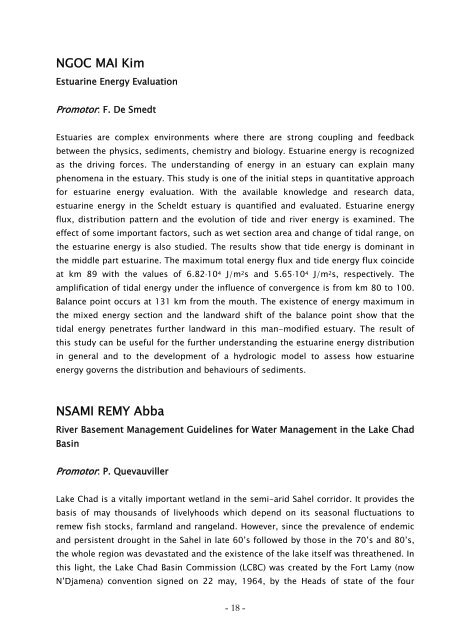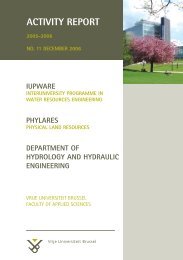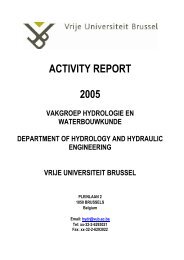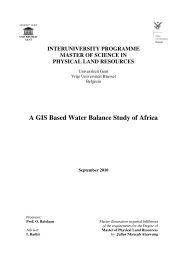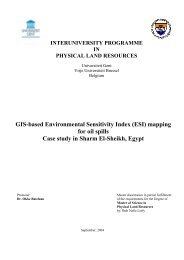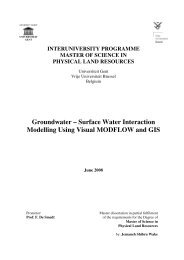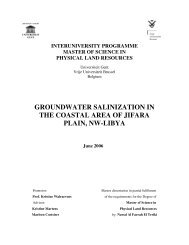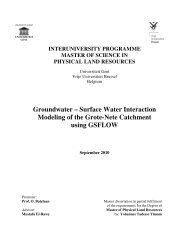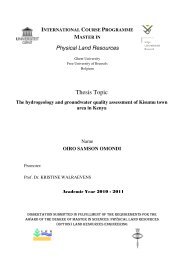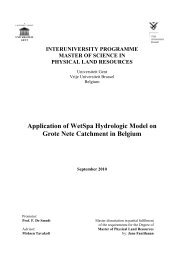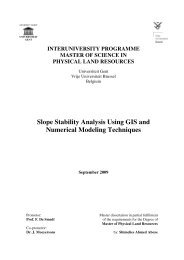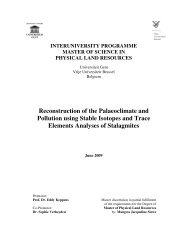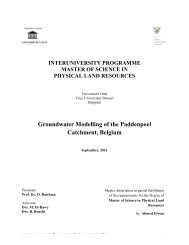C O N T E N T S - Physical Land Resources - Vrije Universiteit Brussel
C O N T E N T S - Physical Land Resources - Vrije Universiteit Brussel
C O N T E N T S - Physical Land Resources - Vrije Universiteit Brussel
You also want an ePaper? Increase the reach of your titles
YUMPU automatically turns print PDFs into web optimized ePapers that Google loves.
NGOC MAI KimEstuarine Energy EvaluationPromotor: F. De SmedtEstuaries are complex environments where there are strong coupling and feedbackbetween the physics, sediments, chemistry and biology. Estuarine energy is recognizedas the driving forces. The understanding of energy in an estuary can explain manyphenomena in the estuary. This study is one of the initial steps in quantitative approachfor estuarine energy evaluation. With the available knowledge and research data,estuarine energy in the Scheldt estuary is quantified and evaluated. Estuarine energyflux, distribution pattern and the evolution of tide and river energy is examined. Theeffect of some important factors, such as wet section area and change of tidal range, onthe estuarine energy is also studied. The results show that tide energy is dominant inthe middle part estuarine. The maximum total energy flux and tide energy flux coincideat km 89 with the values of 6.82⋅10 4 J/m 2 s and 5.65⋅10 4 J/m 2 s, respectively. Theamplification of tidal energy under the influence of convergence is from km 80 to 100.Balance point occurs at 131 km from the mouth. The existence of energy maximum inthe mixed energy section and the landward shift of the balance point show that thetidal energy penetrates further landward in this man-modified estuary. The result ofthis study can be useful for the further understanding the estuarine energy distributionin general and to the development of a hydrologic model to assess how estuarineenergy governs the distribution and behaviours of sediments.NSAMI REMY AbbaRiver Basement Management Guidelines for Water Management in the Lake ChadBasinPromotor: P. QuevauvillerLake Chad is a vitally important wetland in the semi-arid Sahel corridor. It provides thebasis of may thousands of livelyhoods which depend on its seasonal fluctuations toremew fish stocks, farmland and rangeland. However, since the prevalence of endemicand persistent drought in the Sahel in late 60’s followed by those in the 70’s and 80’s,the whole region was devastated and the existence of the lake itself was threathened. Inthis light, the Lake Chad Basin Commission (LCBC) was created by the Fort Lamy (nowN’Djamena) convention signed on 22 may, 1964, by the Heads of state of the four- 18 -


